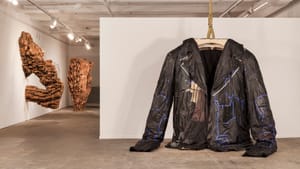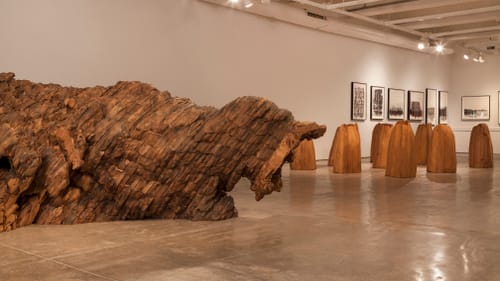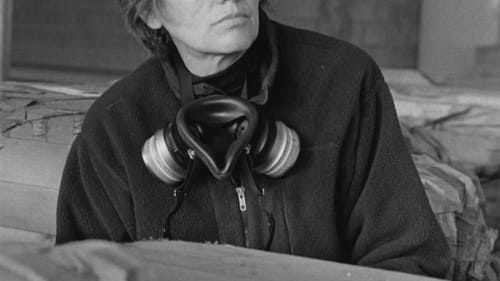Stay in the Loop
BSR publishes on a weekly schedule, with an email newsletter every Wednesday and Thursday morning. There’s no paywall, and subscribing is always free.
Big little art
Fabric Workshop and Museum's 'Ursula von Rydingsvard: The Contour of Feeling'

Ursula von Rydingsvard grows mighty art from acorns made of cedar. An exhibition of her recent work, The Contour of Feeling, sprawls across three floors of the Fabric Workshop and Museum (FWM).
Von Rydingsvard allows works to evolve as naturally as trees, carving four-inch square boards into red-brown chunks and positioning them intuitively. Art unfolds in the moment, a visceral expression of what she senses in the wood, leather, fiber, and in herself.
Marine themes
The works dwarf viewers, placing them at the base of towering trees and the edges of oceans. A ridged mass undulates across 15 feet of the gallery's floor, 6.5 feet wide and 4.5 feet high. It seems to be a beached whale, and the title doesn’t disagree: Ocean Voices (2011-12). Works like this have kept Von Rydingsvard, by her own estimate, on scaffolding for a third of her life.
Other works on view summon thoughts of the sea. “Ocean Floor” (1996) is a basin 13 feet in diameter. Hewn of irregular, graphite-shaded cedar blocks, it has the mysterious look of the briny deep. Or Droga (2009), 4.5 feet high, 9.5 feet wide, and 18 feet long; picture an elephant seal in mid-roar. The name is a Polish word, but the translation — “road” — has nothing to do with seals.
What’s in a name?
Von Rydingsvard is ambivalent about naming works. “I don’t want to make any kind of a literal connection to the title,” she said in 2013. “I would like the title to have something to do with the piece, but it’s only a ‘something’ that’s somewhere in my mind, that cannot be explained so easily. That connection is often obtuse to the world at large.”
As with Droga, Von Rydingsvard occasionally christens works in her native language. She was born to a Polish family in Germany during World War II; the family lived in forced labor camps and after the war, refugee camps. Eventually, they came to the United States, settling in Connecticut.

The title of another work, PODERWAĆ (2017), created at FWM in collaboration with staff, is easily understood. It’s a gargantuan leather jacket suspended on a hanger large enough to support a porch. Its forearms rest on the gallery floor like a sphinx, the torso pooling behind them. The name means "tearing apart." More than 90 leather jackets were dismantled to fashion the garment, which would fit William Penn atop City Hall.
Exploring materials, scale in residencies
PODERWAĆ represents a departure for Von Rydingsvard, who is principally known for working in cedar, but represents her incremental construction and the way the material contains a human touch. The component jackets were collected from thrift stores and flea markets. In a gallery video, the artist speaks about how leather jackets in particular come to represent their owners, and how she wanted to invest the giant jacket with their presence.
Midway through the exhibition, there’s a surprise: 10 normally sized works in frames. To eyes accustomed to the monumental art, they look positively Lilliputian. Composed of fiber, pigment, and embedded objects, the unnamed pieces were completed in 2016 and 2017 during a residency at Dieu Donné, an organization focused on handmade paper.

Set in identical black box frames, they appear as fragile window shades in a palette of black and white, some with a splash of burgundy. Their texture spans a spectrum of delicate linen, crinoline net, and gauzy interludes dripping down into threads so fine that they seem to float within the weave, like plankton.
Living things
Though she explores other materials, Von Rydingsvard returns to cedar because she speaks best through the wood she has used for more than 40 years. Sourced from Vancouver, British Columbia, its rich color and malleability enable her to create works that engage the senses and intellect.
With a straight-bladed saw as her chisel, she shapes towering works like COŚ (2017), which resembles the torso of a woman emerging from a tree, and Scratch II (2015), a wall-mounted piece suggesting the head and trunk of an elephant. In each, the artist’s hand is visible in the cuts and placement of their building blocks.
The arrangement seems inevitable, though Von Rydingsvard eschews planning. She has commented that she finds making models and preparatory drawings “punitive.”
Curated by Mark Rosenthal to survey Von Rydingsvard’s work since 2000, the exhibition takes its name from her favorite poet, Rainer Maria Rilke, who wrote, “We don’t know the contour of feeling; we only know what holds it.”
Von Rydingsvard’s work at FWM, as well as two pieces on view at the Philadelphia Museum of Art’s Anne d’Harnoncourt Sculpture Garden, are vessels to hold — but not contour — viewers’ own feelings.
What, When, Where
Ursula von Rydingsvard: The Contour of Feeling. Through August 26, 2018, at the Fabric Workshop and Museum; 1214 Arch Street, Philadelphia. (215) 561-8888 or fabricworkshopandmuseum.org.
Sign up for our newsletter
All of the week's new articles, all in one place. Sign up for the free weekly BSR newsletters, and don't miss a conversation.